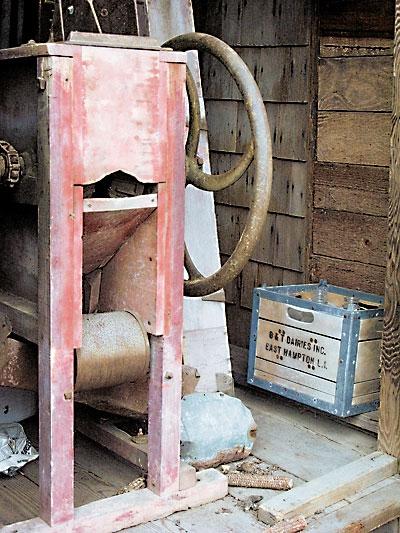Visions of a Lester Farm Museum

Standing in front of the barn at the historic Lester farm site on North Main Street in East Hampton, Prudence Carabine’s eyes gleamed as she talked about one day seeing visitors entering the barn to see what equipment and tools a farming family might have kept there at the turn of the 20th century.
Meeting on Monday at the property, purchased and preserved by East Hampton Town, a committee of volunteers working to establish an East Hampton Farm Museum discussed the next steps in a process that has already spanned several years.
In the spring, they hope, a garden of peas, spinach, and lettuce will go in, and the produce used to show visitors traditional means of putting up food, with canning and preserving done in an authentically restored working kitchen.
Inside the house, the group discussed where various items, salvaged from the barn at the old Tillinghast Dairy on Woods Lane in East Hampton before the buildings there were sold and torn down, could be placed. A cast-iron wood cookstove will be hooked up in one corner; along another wall will go the icebox and a deep double porcelain sink. A Hoosier cabinet will fit into another spot.
The Revolutionary War-era house was built for Capt. Jonathan Barnes of Amagansett, who lived on Old Montauk Highway in that hamlet. In 1870, it was sold to Selah Lester, who had it moved to its present location, on close to three acres at the corner of Cedar Street and North Main.
The property had been owned by the Dominy family, cabinetmakers and clockmakers who had a wind-powered sawmill there. Now, the house and barn remain on the large open lot, where the museum committee members picture the public strolling, viewing history exhibits, and generally soaking in a sense of the lives lived by members of an East Hampton farm family in the early 1900s.
Ms. Carabine said earlier this week that the committee chose to focus on depicting that era because it was a “stepping-off point” into the new century “but still had enough flavor of the Civil War — the 1800s.”
“There was a forward push, faster,” at that time, she said, “to cars, electricity, and all of that. After people came back from the Civil War” and began to prosper, “their whole lives focused on their farm. What they couldn’t raise, they bartered.”
The East Hampton Historical Society’s Mulford Farm represents the 1700s, she said, and, if a hoped-for deal to acquire and preserve the old Sherrill Dairy site, just across and up North Main Street, pans out, that would provide a window into the 1800s, when that dairying operation started.
“There is nothing like this on the South Fork,” said Ms. Carabine, who, with a long family lineage here, has taped interviews with a number of old-timers for the cable station LTV, and has been a driving force behind the farm museum idea after it was first proposed by Carla Ash, another committee member, at an East Hampton Citizens Advisory Committee meeting.
“My grandfather just spoke to me in that moment,” Ms. Carabine said Monday.
Ms. Ash, a curator, will recreate an authentic “front room” on the lower level of the Barnes/Lester house, as well as a period bedroom upstairs. A second upstairs room will be outfitted to serve as a library and conference room, and a downstairs room will become a media-rich exhibit area where, for instance, visitors could view some of Ms. Carabine’s oral-history videos.
The exhibits will be paid for with money from fund-raising efforts and, possibly, grants. Structural restoration, some of which has already been completed, can be covered by the town using money from the community preservation fund earmarked for historic preservation.
Scott Wilson, the town’s director of land acquisitions and management, who has been working closely with the committee, said that after the structural work on the house and barn has been done, the town would sign a license agreement with a new nonprofit agency being set up to run the farm museum.
The East Hampton Historical Society is currently serving as an umbrella organization; Richard Barons, its director, is a member of the committee. Donations may be accepted by the society for the museum effort.
“We need to have the enthusiastic efforts of volunteers — and the support of the town board,” said Ms. Carabine.
The East End Cooperative Organic Farm in East Hampton, Alex Balsam, a farmer, attorney, and member of the farm museum committee, reported Tuesday, will help with the garden. Discussion turned to use of authentic organic methods, such as using fish heads, seaweed, and chicken manure to enrich the soil, and how to succeed at growing anything without a modern-day deer fence. There were fewer deer back then, Ms. Carabine said. Group members passed around a book on fencing published in 1887 that provided some ideas.
Plans will proceed under the guidance of a lengthy report written by Robert Hefner, a historical consultant who detailed the history of the property and its days and times.
The Tillinghast barn, which had remained in that family for 250 years, according to Ms. Carabine, provided a treasure trove: six truckloads of items, from 150-year-old tools, horse gear and wagons, furniture, and farming and dairying equipment to “odd things,” like a standing geared device designed for husking corn.
Inside the Lester farm kitchen, on a narrow strip inside a closet and on a patch of siding underneath the hand-hewn roof beams, a little gem was found: remnants of sweet, posy-covered wallpaper that probably perked up the early 1900s kitchen. Not only will the scraps be preserved, but the farm museum committee hopes to find a benefactor who would underwrite the reproduction of more of it, so that more of the kitchen can be covered with the cheery patina.
